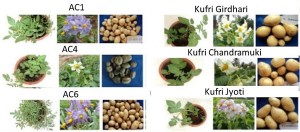
22 July, 2017
 Late Blight caused by Phytophthora infestans is the most destructive foliar disease causing 30% yield losses in the potato crop globally. Some of the wild potato genotypes and cultivars are highly resistant, whereas some other wild genotypes and cultivars are susceptible to Late Blight. In the current study, the calli of six potato genotypes were used to understand the mechanism of cellular resistance to Late Blight. Exposure to P. infestansor its elicitors significantly induced peroxidase (POX) and superoxide dismutase (SOD) activities, and induced accumulation of phenolics and flavonoids, indicating the capability of the calli cells to mount a defense response. The study is the first to report the extracellular secretion of defense enzymes, SOD and POX when cells encounter the pathogen, implicating a similar whole-plant phenomenon of enhanced defense in the apoplast. Interestingly, the calli of resistant genotypes showed poor survival upon exposure to pathogen or when grown on elicitor medium, while the susceptible genotypes showed better survival. The percentage of calli cells accumulating intracellular H2O2 was high in resistant genotypes, and directly correlated with the observed higher cell death. The study shows that H2O2 accumulation in the cells of resistant genotypes is indeed self-destructive, a whole plant phenomenon termed hypersensitive response – cell death at site of infection. The potato callus system thus can be used to gain new insights into the plant-defense response to P. infestans. Read full article at www.plantsciencetoday.online
Late Blight caused by Phytophthora infestans is the most destructive foliar disease causing 30% yield losses in the potato crop globally. Some of the wild potato genotypes and cultivars are highly resistant, whereas some other wild genotypes and cultivars are susceptible to Late Blight. In the current study, the calli of six potato genotypes were used to understand the mechanism of cellular resistance to Late Blight. Exposure to P. infestansor its elicitors significantly induced peroxidase (POX) and superoxide dismutase (SOD) activities, and induced accumulation of phenolics and flavonoids, indicating the capability of the calli cells to mount a defense response. The study is the first to report the extracellular secretion of defense enzymes, SOD and POX when cells encounter the pathogen, implicating a similar whole-plant phenomenon of enhanced defense in the apoplast. Interestingly, the calli of resistant genotypes showed poor survival upon exposure to pathogen or when grown on elicitor medium, while the susceptible genotypes showed better survival. The percentage of calli cells accumulating intracellular H2O2 was high in resistant genotypes, and directly correlated with the observed higher cell death. The study shows that H2O2 accumulation in the cells of resistant genotypes is indeed self-destructive, a whole plant phenomenon termed hypersensitive response – cell death at site of infection. The potato callus system thus can be used to gain new insights into the plant-defense response to P. infestans. Read full article at www.plantsciencetoday.online